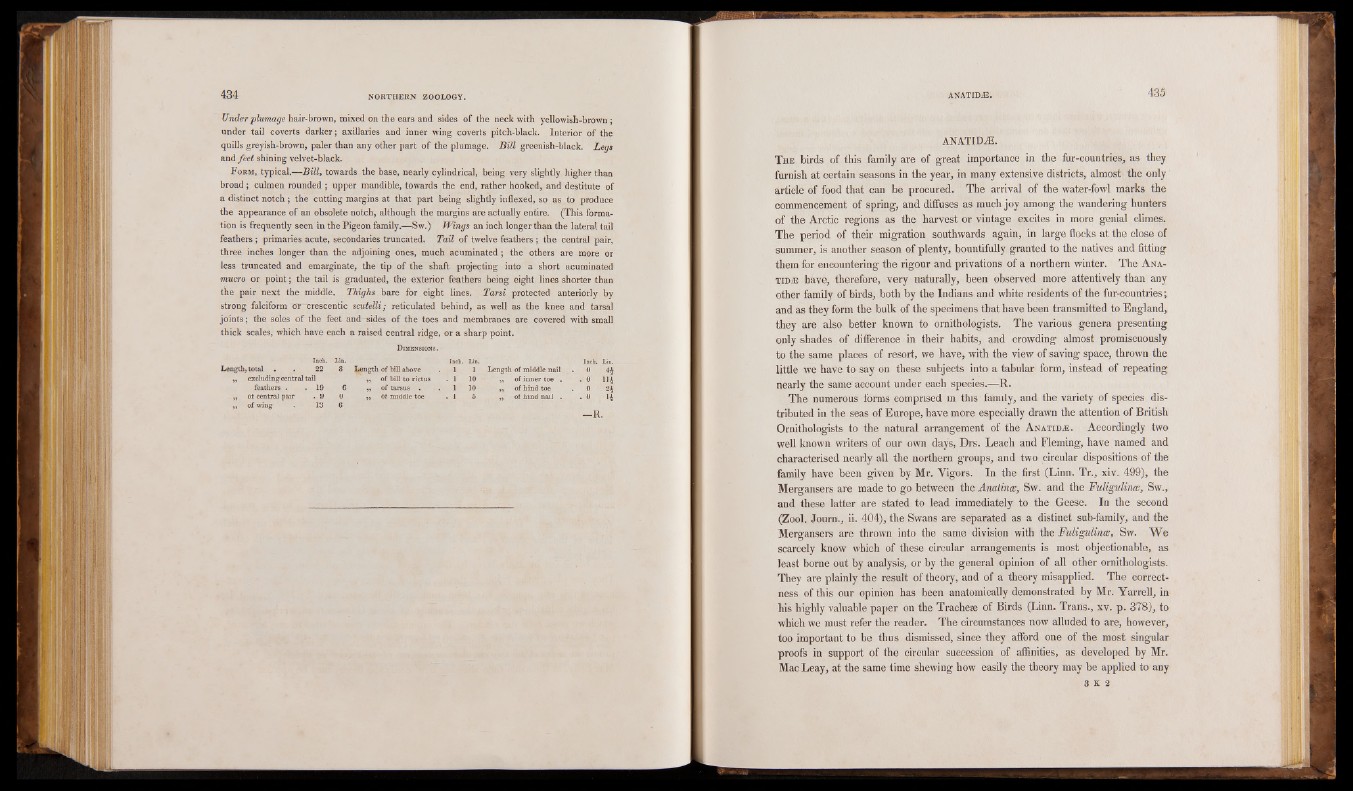
Under‘plumage hair-brown, mixed on the ears and sides of the neck with yellowish-brown ;
under tail coverts darker; axillaries and inner wing coverts pitch-black. Interior of the
quills greyish-brown, paler than any other part of the plumage. Bill greenish-black. Legs
and feet shining velvet-black.
Form, typical.—Bill, towards the base, nearly cylindrical, being very slightly higher than
broad; culmen rounded ; upper mandible, towards the end, rather hooked, and destitute of
a distinct notch; the cutting margins at that part being slightly indexed, so as to produce
the appearance of an obsolete notch, although the margins are actually entire. (This formation
is frequently seen in the Pigeon family.—Sw.) Wings an inch longer than the lateral tail
feathers; primaries acute, secondaries truncated. Tail of twelve feathers ; the central pair,
three inches longer than the adjoining ones, much acuminated ; the others are more or
less truncated and emarginate, the tip of the shaft projecting into a short acuminated
mucro or point; the tail is graduated, the exterior feathers being eight lines shorter than
the pair next the middle. Thighs bare for eight lines. Tarsi protected anteriorly by
strong falciform or~crescentic scutelli; reticulated behind, as well as the knee and tarsal
joints; the soles of the feet and sides of the toes and membranes are covered with small
thick scales, which have each a raised central ridge, or a sharp point.
Dimensions.
Length, total 22 8 Length of bill above
Inch. Lin.
1 1 Length of middle nail
Inch. !
0 „ excluding central tail ,, of bill to rictus . 1 10 ■ ' ,, of inner toe . . 0 feathers . . 19 6 ,, of tarsus . 1 10 T, of hind toe 0 _„ of central pair . 9 0 „ of middle toe . 1 5 „ of hind nail . ,, of wing 13 6 • o
— R.
ANATIDjE.
The birds of this family are of great importance in the fur-countries, as they
furnish at certain seasons in the year, in many extensive districts, almost the only
article of food that can be procured. The arrival of the water-fowl marks the
commencement of spring, and diffuses as much joy among the wandering hunters
of the Arctic regions as the harvest or vintage excites in more genial climes.
The period of their migration southwards again, in large flocks at the close of
summer, is another season of plenty, bountifully granted to the natives and fitting
them for encountering the rigour and privations of a northern winter. The A na- TiD/E have, therefore, very naturally, been observed more attentively than any
other family of birds, both by the Indians and white residents of the fur-countries;
and as they form the bulk of the specimens that have been transmitted to England,
they are also better known to ornithologists. The various genera presenting
only shades of difference in their habits, and crowding almost promiscuously
to the same places of resort, we have, with the view of saving space, thrown the
little we have to say on these subjects into a tabular form, instead of repeating
nearly the same' account under each species.—R.
The numerous forms comprised in this family, and the variety of species distributed
in the seas of Europe, have more especially drawn the attention of British
Ornithologists to the natural arrangement of the A natid,®. Accordingly two
well known writers of our own days, Drs. Leach and Fleming, have named and
characterised nearly all the northern groups, and two circular dispositions of the
family have been given by Mr. Vigors. In the first (Linn. Tr., xiv. 499), the
Mergansers are made to go between the Anatinw, Sw. and the Fuligulinw, Sw.,
and these latter are stated to lead immediately to the Geese. In the second
(Zool. Journ., ii. 404), the Swans are separated as a distinct sub-family, and the
Mergansers are thrown into the same division with the Fuligulinw, Sw. We
scarcely know which of these circular arrangements is most objectionable, as
least borne out by analysis, or by the general opinion of all other ornithologists.
They are plainly the result of theory, and of a theory misapplied. The correctness
of this our opinion has been anatomically demonstrated by Mr. Yarrell, in
his highly valuable paper on the Tracheae of Birds (Linn. Trans., xv. p. 378), to
which we must refer the reader. The circumstances now alluded to are, however,
too important to be thus dismissed, since they afford one of the most singular
proofs in support of the circular succession of affinities, as developed by Mr.
Mac Leay, at the same time shewing how easily the theory may be applied to any
3 K 2